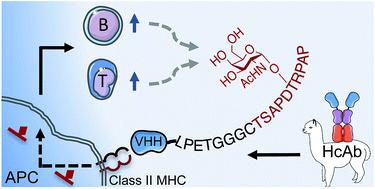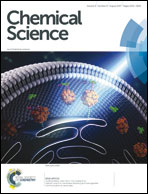Targeted antigen delivery by an anti-class II MHC VHH elicits focused αMUC1(Tn) immunity†
Abstract
Unusual patterns of glycosylation on the surface of transformed cells contribute to immune modulation and metastasis of malignant tumors. Active immunization against them requires effective antigen presentation, which is complicated by a lack of access to tumor-specific posttranslational modifications through standard genetic approaches and by the low efficiency of passive antigen sampling. We found that antigen targeted to antigen presenting cells via class II MHC products can elicit a robust immune response against MUC1(Tn) bearing a defined tumor-associated glycoform, Tn. The two-component vaccine construct was prepared by sortase-mediated protein ligation of a synthetic MUC1(Tn) fragment to a class II MHC-binding single-domain antibody fragment (VHH7) as targeting moiety. We show that VHH7 targets antigen presenting cells in vivo, and when conjugated to MUC1(Tn) can elicit a strong αMUC1(Tn) immune response in mice. The resulting sera preferentially recognized the MUC1 epitope with the tumor-associated carbohydrate antigen Tn and were capable of killing cancer cells in a complement-mediated cytotoxicity assay. Immunoglobulin isotype analysis and cytokine release assays suggested a favorable Th1 response. A single boost 12 months after primary immunization triggered a recall response of the same quality, suggesting that long-term αMUC1(Tn) memory had been achieved.



 Please wait while we load your content...
Please wait while we load your content...